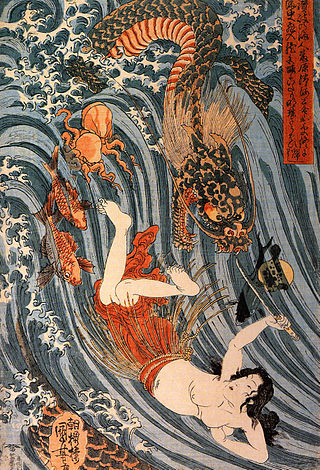In Māori mythology, taniwha are large supernatural beings that live in deep pools in rivers, dark caves, or in the sea, especially in places with dangerous currents or deceptive breakers . They may be considered highly respected kaitiaki of people and places, or in some traditions as dangerous, predatory beings, which for example would kidnap women to have as wives.
The Abenaki people are an indigenous peoples of the Americas located in the Northeastern Woodlands region. Their religious beliefs are part of the Midewiwin tradition, with ceremonies led by medicine keepers, called Medeoulin or Mdawinno.
Māui or Maui is the great culture hero and trickster in Polynesian mythology. Very rarely was Māui actually worshipped, being less of a deity (Demigod) and more of a folk hero. His origins vary from culture to culture, but many of his main exploits remain relatively similar.

Chinese mythology is mythology that has been passed down in oral form or recorded in literature throughout the area now known as Greater China. Chinese mythology encompasses a diverse array of myths derived from regional and cultural traditions. Populated with engaging narratives featuring extraordinary individuals and beings endowed with magical powers, these stories often unfold in fantastical mythological realms or historical epochs. Similar to numerous other mythologies, Chinese mythology has historically been regarded, at least partially, as a factual record of the past.

Ryūjin, which in some traditions is equivalent to Ōwatatsumi, was the tutelary deity of the sea in Japanese mythology. In many versions Ryūjin had the ability to transform into a human shape. Many believed the god had knowledge on medicine and many considered him as the bringer of rain and thunder, Ryūjin is also the patron god (ujigami) of several family groups.
In Pahang Malay folklore, the Seri Gumum Dragon is a legendary giant serpent locally called Nāga and commonly described as taking the form of an Asian dragon, that inhabit the Chini Lake in Pahang, Malaysia. There have been a variety of legends associated with the creature in the oral literature. The notable one is related to the origin myth of the lake itself, while another legend narrates about a love story between female Seri Gumum and a male Nāga called Seri Kemboja that leads to the origin myth of Tioman and Lingga Islands.

Brazilian mythology is the subset of Brazilian folklore with cultural elements of diverse origin found in Brazil, comprising folk tales, traditions, characters and beliefs regarding places, people, and entities. The category was originally restricted to indigenous elements, but has been extended to include:

The Legend of the White Snake is a Chinese legend centered around a romance between a man named Xu Xian and a female snake spirit named Bai Suzhen. It is counted as one of China's Four Great Folktales, the others being Lady Meng Jiang, Butterfly Lovers, and The Cowherd and the Weaver Girl.

Melanesian mythology refers to the folklore, myths, and religions of Melanesia, a region in Southwest Oceania that encompasses the archipelagos of New Guinea, the Torres Strait Islands, Solomon Islands, Vanuatu, New Caledonia and Fiji. The various mythologies consist primarily of the traditions of oral literature in the different populations of Melanesia. More recent aspects include the cargo cults born in the 20th century during the Pacific War.

Māori mythology and Māori traditions are two major categories into which the remote oral history of New Zealand's Māori may be divided. Māori myths concern tales of supernatural events relating to the origins of what was the observable world for the pre-European Māori, often involving gods and demigods. Māori tradition concerns more folkloric legends often involving historical or semi-historical forebears. Both categories merge in whakapapa to explain the overall origin of the Māori and their connections to the world which they lived in.

In Hawaiian religion, Māui is a culture hero and ancient chief who appears in several different genealogies. In the Kumulipo, he is the son of ʻAkalana and his wife Hina-a-ke-ahi (Hina). This couple has four sons, Māui-mua, Māui-waena, Māui-kiʻikiʻi, and Māui-a-kalana. Māui-a-kalana's wife is named Hinakealohaila, and his son is named Nanamaoa. Māui is one of the Kupua. His name is the same as that of the Hawaiian island Maui, although native tradition holds that it is not named for him directly, but instead named after the son of Hawaii's discoverer.
The legend of Trentren Vilu and Caicai Vilu (Kaikai) is a Mapuche flood myth that tells the story of a fierce battle between two mythical snakes, Trentren Vilu and Caicai Vilu. It explains how the Chilóe archipelago and mountains of southern Chile came to have its unique geography.

In Canadian folklore, Cressie is the nickname given to an eel-like lake monster said to reside in Crescent Lake, Robert's Arm, Newfoundland and Labrador, Canada. The name is a portmanteau of Crescent Lake and Nessie, the nickname given to the Loch Ness Monster. The monster has been described as resembling a large dark brown eel around 15 feet in length with a long, sleek body and as "looking long and shiny, and having a fish-like head." Claims of Cressie being sighted began in the 1950s, and continue to the present day.
Gun, also known as Count of Chong, is a figure in Chinese mythology, sometimes noted as the father of Yu the Great, the founder of the Xia dynasty. Gun was appointed to the task of controlling the Great Flood by Emperor Yao on the advice of the Four Mountains. Gun used dykes to try to stop the flooding but the dykes collapsed, killing many people.

Inca mythology is the universe of legends and collective memory of the Inca civilization, which took place in the current territories of Colombia, Ecuador, Peru, Bolivia, Chile, and Argentina, incorporating in the first instance, systematically, the territories of the central highlands of Peru to the north.









